Herbal tea blending is all about creating unique flavors that cater to your taste. Start with a base herb, then mix in flavor enhancers and complementary herbs. For balanced infusions, try a 2:1:1 ratio of base to flavor to complementary herbs. If you prefer a more robust taste, a 3:2:1 ratio works well. Don't be afraid to experiment! Adjust the ratios based on your preferences, and taste your infusions along the way. This way, you'll craft the perfect cup every time. Stick around for more insights on refining your herbal tea blends for an even more enjoyable experience.
Understanding Herbal Tea Basics
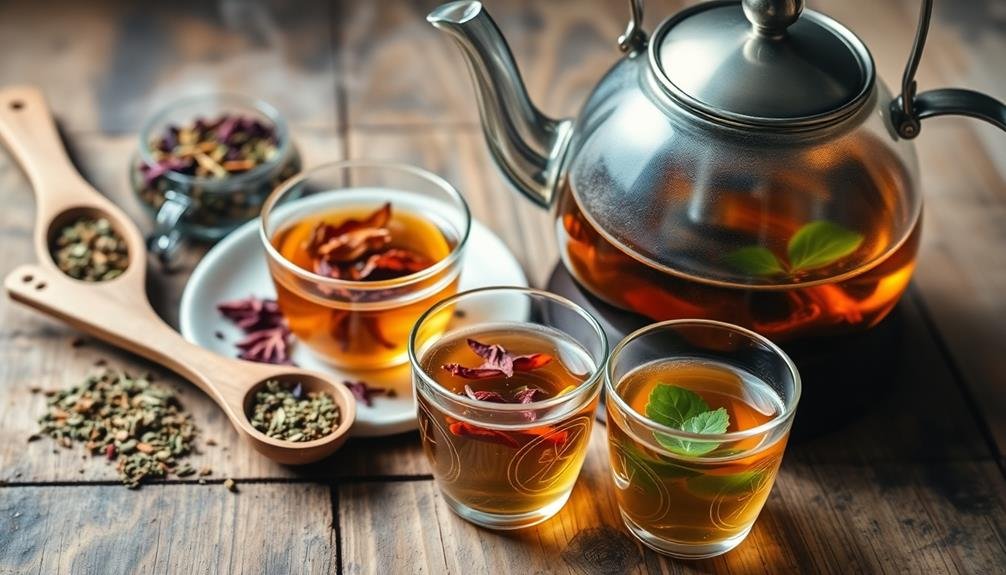
When you immerse yourself in the world of herbal tea, you'll quickly discover that it's more than just a soothing beverage; it's a blend of diverse flavors and health benefits. Understanding the basics of herbal tea is your first step toward creating delightful infusions.
Unlike traditional tea, herbal tea can include a variety of plants, flowers, and spices, often leading to unique taste profiles.
Start by recognizing the key ingredients. Herbs like peppermint and chamomile can provide invigorating or calming qualities, while fruits like hibiscus add a tangy twist. You'll find that each ingredient has its own distinct flavor and potential health properties, so experimenting is essential.
Next, pay attention to brewing times and temperatures. For most herbal teas, you'll want to steep them in boiling water for 5 to 10 minutes to fully extract flavors and benefits. The longer you steep, the stronger the infusion.
Lastly, don't hesitate to blend different herbs and spices to create your signature mix. You can even adjust the ratios based on your personal taste preferences. This exploration will deepen your appreciation for herbal tea and empower you to create customized blends.
Benefits of Herbal Tea Blending
Blending herbal teas offers a multitude of benefits that can enhance both your experience and health. When you combine different herbs, you create unique flavor profiles that can elevate your tea-drinking ritual.
You'll find that experimenting with various blends not only keeps things interesting but also allows you to discover new favorites tailored to your taste.
Moreover, blending enables you to harness the specific health benefits of each herb. By mixing herbs with complementary properties, you can create a cup that supports your wellness goals, whether you're aiming for relaxation, immunity boost, or digestive aid.
You can personalize your blends to cater to your needs—like a calming chamomile and lavender mix for stress relief or a zesty ginger and lemon combination to invigorate your day.
Additionally, blending can be cost-effective. Instead of purchasing multiple pre-packaged teas, you can buy bulk herbs and create your own signature blends.
This not only saves money but also gives you control over the quality and freshness of the ingredients.
In short, herbal tea blending allows you to enhance your sensory experience, promote your health, and exercise your creativity.
Essential Ingredients for Blends
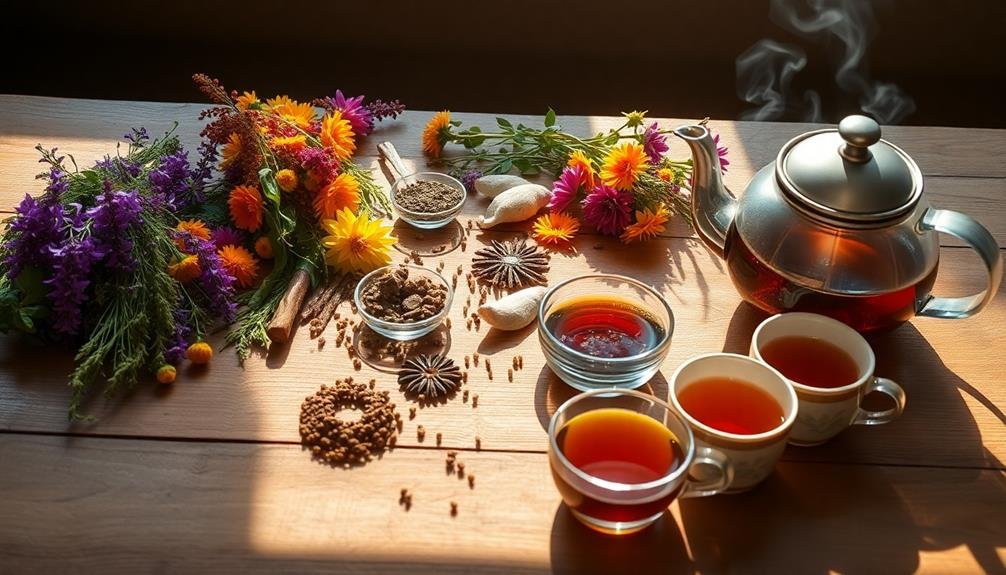
Creating the perfect herbal tea blend requires a few essential ingredients that can transform your cup into a delightful experience. Start with a base, like chamomile or rooibos, to provide a smooth foundation. These bases offer distinct flavors and health benefits, setting the stage for your blend.
Next, add flavor enhancers such as mint, ginger, or citrus peels. These ingredients can brighten your blend, adding an invigorating or zesty kick.
Don't forget to incorporate complementary herbs, like lavender or lemongrass, which can harmonize the flavors and create a more complex profile.
You'll also want to take into account adding botanicals that contribute to aroma and color, like dried flowers or spices. They not only enhance the visual appeal but also elevate the sensory experience of your tea.
Common Herbal Tea Types
Herbal teas come in countless varieties, each offering unique flavors and benefits that cater to different tastes and preferences. One popular type is chamomile, known for its soothing properties that help you unwind after a long day. Its gentle floral notes make it a perfect bedtime drink.
If you're looking for something invigorating, consider peppermint tea. Its revitalizing taste not only wakes you up but also aids digestion.
Another common choice is hibiscus tea, which boasts a tart flavor reminiscent of cranberries. Rich in antioxidants, it's often enjoyed both hot and iced.
For those seeking a calming experience, lemon balm is a delightful option. This lemon-scented herb can reduce stress and promote relaxation.
Rooibos tea, originating from South Africa, has a naturally sweet taste and is caffeine-free, making it an excellent choice for any time of day.
Finally, you might want to explore ginger tea, known for its spicy kick and health benefits, including anti-inflammatory properties.
With so many herbal tea types available, you can easily find one that fits your mood, whether you need to relax, energize, or simply enjoy a flavorful cup.
Recommended Blending Ratios
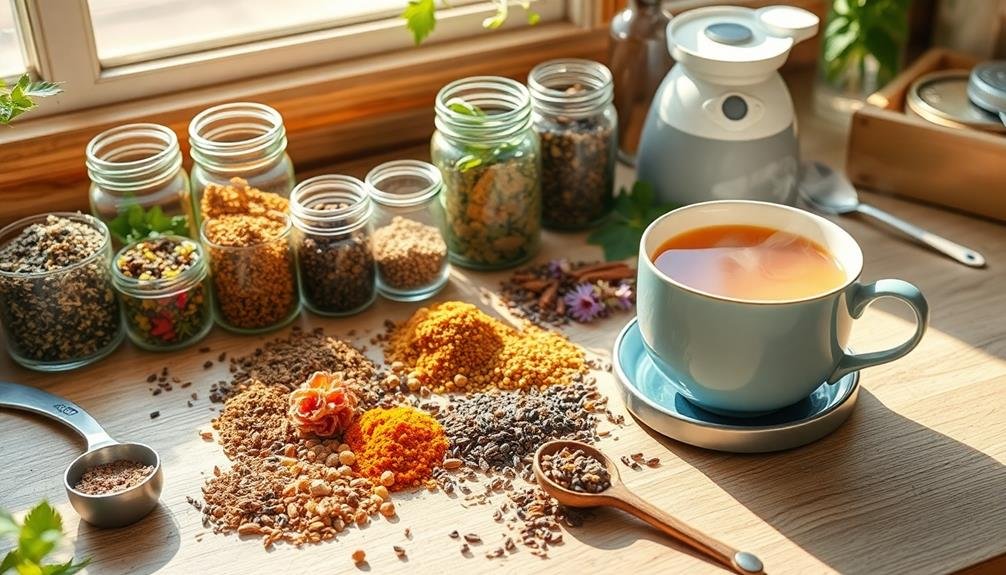
When it comes to crafting your perfect cup, finding the right blending ratios can make all the difference. A good starting point is a 2:1:1 ratio, which combines a base herb, a flavor herb, and a complementary herb.
For example, you might use two parts chamomile, one part peppermint, and one part lemon balm. This creates a balanced flavor profile that's both soothing and invigorating.
If you prefer a more robust infusion, try a 3:2:1 ratio. Here, you can use three parts of a stronger herb like hibiscus, two parts of a milder herb like apple pieces, and one part of a spice like cinnamon.
This approach gives your tea depth without overwhelming your palate.
For a floral twist, consider a 1:1:1 ratio. Combine equal parts lavender, rose petals, and lemon verbena.
This blend brings a delightful aroma and a touch of sweetness.
Adjusting Ratios for Flavor
Finding the right flavor balance in your tea can elevate your brewing experience. To adjust ratios for flavor, start by considering your base herbs. If you're using a strong herb like peppermint, you might want to use less of it compared to a milder herb like chamomile. A good rule of thumb is to begin with a 1:2 ratio of strong to mild herbs, then tweak it based on your taste preferences.
As you blend, taste your infusion at different stages. If you find it too herbal or intense, dilute it with more of the milder herb. Conversely, if the flavor seems weak, increase the stronger herb gradually.
Keep in mind the natural oils and compounds in herbs can intensify over steeping, so adjust your ratios accordingly.
Don't forget about the steeping time; it can impact flavor intensity too. A longer steep will bring out more of the herb's natural characteristics.
Experiment with different combinations and document your favorite ratios. This way, you'll develop a personal blend that truly reflects your taste. Enjoy the process, and don't hesitate to make adjustments until you find your perfect infusion!
Balancing Tastes and Aromas
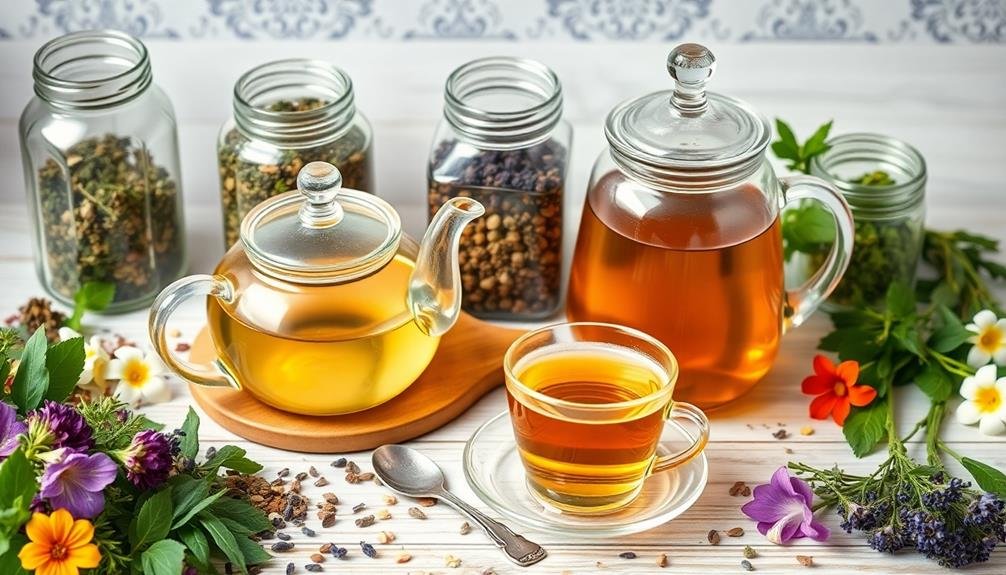
Adjusting the ratios of your herbs is just the beginning; balancing the tastes and aromas is where the magic happens. When you blend, think about the primary flavors you want to highlight. Are you aiming for something floral, spicy, or earthy? Each herb will contribute its unique profile, so it's essential to take into account how they interact.
Start by choosing a dominant herb that sets the tone for your infusion. Then, add complementary herbs to enhance its flavor without overpowering it. For instance, if you're using chamomile, think about adding a hint of mint or lemon balm for brightness.
Don't forget about the aroma—scents can dramatically alter perceptions of taste.
As you blend, taste your mixture frequently. Steep a small sample to gauge how the flavors evolve. If something feels off, adjust your ratios. Maybe you need a touch more sweetness or a pinch of spice.
Don't shy away from experimenting; finding the right balance might take a few tries. With practice, you'll refine your intuition for what works, creating herbal teas that not only taste great but also delight the senses.
Happy blending!
Layering Herbs for Depth
When layering herbs for depth, you'll want to choose complementary herbs that enhance each other's flavors and aromas.
Think about how different herbs can balance out or amplify each other, creating a more complex brew. This approach not only enriches your tea but also elevates the overall experience.
Choosing Complementary Herbs
To create a truly aromatic and flavorful herbal tea, you'll want to choose complementary herbs that enhance each other's qualities. Start by considering the primary herb that will serve as the foundation of your blend. This herb should have a strong flavor or aroma that you want to highlight.
Next, think about which herbs will support or elevate this primary choice. For instance, if you're using chamomile for its soothing properties, consider adding a hint of peppermint for a revitalizing twist. Both herbs work well together, with peppermint adding a cool finish to chamomile's gentle warmth.
Similarly, if you choose hibiscus for its tartness, you might add a touch of rose hips, which can provide a subtle sweetness and additional health benefits.
When selecting your complementary herbs, aim for a balance of textures and properties. Some herbs may be more robust, while others can be delicate. By layering herbs with varying intensities, you create depth in your tea, making each sip a delightful experience.
Remember to experiment and trust your palate—each combination can yield unique and satisfying results!
Balancing Flavors and Aromas
Layering herbs not only enhances the overall experience of your tea but also helps in balancing flavors and aromas. When you blend different herbs, contemplate how their profiles interact. For instance, if you choose a strong herb like peppermint, think about adding a milder herb like chamomile to soften its intensity. This way, you create a harmonious blend that's pleasant to sip.
Start by identifying the primary flavor you want to highlight. Then, select complementary herbs that either enhance or contrast that flavor. Aim for a balance between sweet, bitter, and savory notes. Use ratios to guide you; a good starting point is 60% of your dominant herb and 20% each of two supporting herbs.
Don't forget to contemplate aroma; a fragrant herb can elevate your blend. For example, a pinch of lavender can add a floral note that lifts the entire infusion.
Experiment with different combinations and adjust according to your taste preferences. Remember, the goal is to create depth and complexity without one flavor overpowering the others. Keep tasting and refining until you find your perfect balance.
Creating Caffeine-Free Options
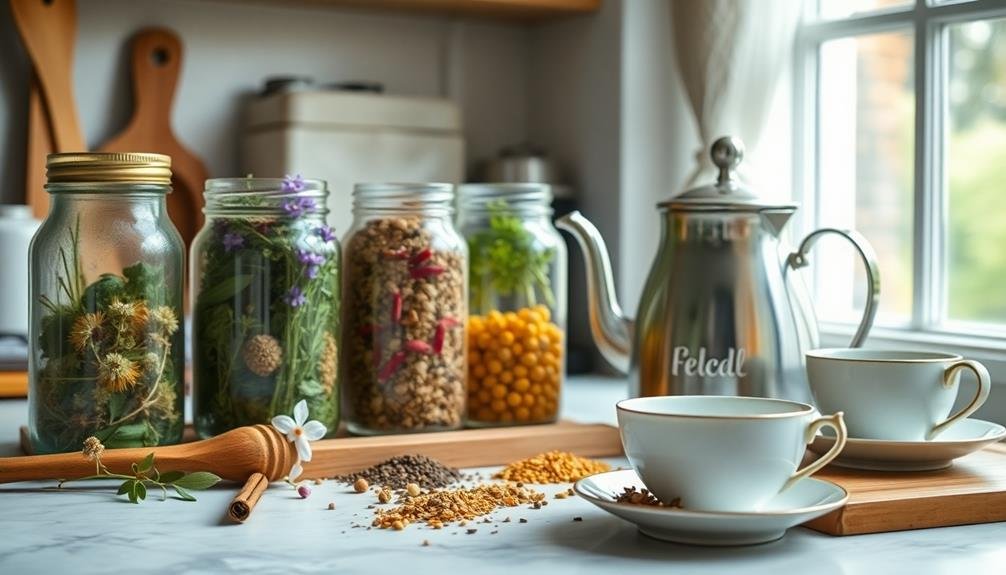
Creating caffeine-free herbal tea blends opens up a world of soothing flavors and health benefits. You can enjoy these blends any time of day without worrying about sleepless nights.
With a little creativity, you'll discover how to mix various herbs for delightful infusions. Here are some great herbs to contemplate when crafting your caffeine-free options:
- Chamomile – Known for its calming properties, chamomile helps with relaxation and sleep.
- Peppermint – This invigorating herb aids digestion and adds a zesty twist to your blends.
- Lemon Balm – With its light lemony flavor, lemon balm is perfect for reducing stress and boosting mood.
- Hibiscus – Rich in antioxidants, hibiscus adds a tart flavor and beautiful color to your tea.
To create your unique blend, start with a base herb, then add complementary flavors. Aim for a ratio of 2:1:1 for a balanced infusion.
For example, if you choose chamomile as your base, mix it with peppermint and hibiscus. Experiment with different combinations, and you'll soon find your perfect caffeine-free herbal tea blend!
Seasonal Blending Ideas
When you think about herbal tea blending throughout the seasons, you'll find that each time of year offers unique flavors and aromas to explore.
In spring, fresh herbs like mint and lemon balm can create a revitalizing blend. Pair them with floral notes from chamomile or hibiscus for an invigorating infusion that captures the season's essence.
As summer rolls in, think about fruity blends. Dried fruits like apple, peach, or berries mixed with a base of rooibos or green tea can provide a delightful iced tea.
Add a hint of citrus zest for an extra zing.
When autumn arrives, embrace warming spices. Combine cinnamon, ginger, and cloves with rooibos or chai for a cozy, comforting brew.
You might also want to incorporate dried leaves from apple or pear to capture those fall flavors.
Storage Tips for Blends
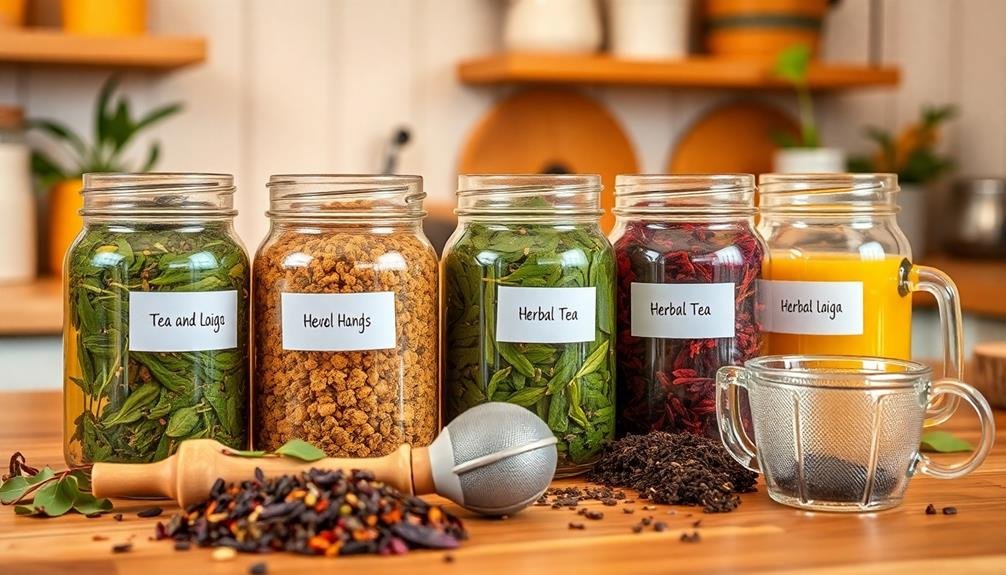
To keep your herbal tea blends fresh, it's essential to store them properly.
You'll want to use airtight containers and maintain an ideal temperature and humidity level.
Understanding shelf life guidelines will also help you enjoy your blends at their best.
Airtight Container Recommendations
Choosing the right airtight container is essential for preserving the freshness and flavor of your herbal tea blends. Storing your teas properly can make a significant difference in their longevity and taste. Here are some recommendations to help you select the best options:
- Glass Jars: Opt for dark glass jars to block out light, which can degrade your blends. They're also non-reactive, ensuring no chemical leaching occurs.
- Metal Tins: Look for tins with a tight-fitting lid. Metal containers provide excellent protection against light and air, keeping your herbal blends fresh longer.
- Plastic Containers: Choose BPA-free plastic containers with airtight seals. While they're lightweight and durable, make sure they're opaque to prevent light exposure.
- Vacuum-Sealed Bags: For bulk storage, vacuum-sealed bags can be a great option. They remove air, which helps prevent oxidation and maintain flavor.
Ideal Temperature and Humidity
The ideal temperature and humidity for storing your herbal tea blends can greatly influence their flavor and potency. Aim to keep your blends in a cool, dark place, preferably between 60°F and 75°F (15°C to 24°C). High temperatures can cause the delicate oils in your herbs to evaporate, leading to a loss of aroma and taste.
Humidity is just as important. Too much moisture can encourage mold growth and spoil your blends, while too little can dry them out, diminishing their flavors. The best humidity level is around 60%. To achieve this, store your blends in an airtight container, away from windows and heat sources like stoves or ovens.
If you live in a particularly humid area, consider using a desiccant packet inside the container to absorb excess moisture. Conversely, if you're in a dry climate, make sure your container seals tightly to prevent your herbs from becoming overly dry.
Shelf Life Guidelines
Maintaining the right storage conditions not only preserves flavor and aroma but also impacts the shelf life of your herbal tea blends. To guarantee your blends stay fresh for as long as possible, follow these essential guidelines:
- Use Airtight Containers: Store your blends in airtight jars to protect against moisture and air exposure, which can degrade quality.
- Keep Away from Light: Store your containers in a cool, dark place. Direct sunlight can cause the herbs to lose their potency and flavor.
- Control Temperature: Aim for a consistent temperature, ideally around 70°F (21°C). Fluctuations can lead to moisture buildup and spoilage.
- Label and Date: Always label your blends with the date they were created. Most herbal blends can last up to 1-2 years if stored properly, but freshness is best within the first 6-12 months.
Tools for Herbal Blending
When starting on your herbal blending journey, having the right tools at your fingertips can make all the difference. First, invest in a good scale for precise measurements. Accurate ratios of herbs are vital for achieving the perfect flavor and potency.
You'll also want a quality mortar and pestle or a herb grinder to break down your ingredients. This helps release essential oils and enhance the infusion.
Next, gather mixing bowls or containers for combining your herbs. Make sure they're clean and dry to preserve the integrity of your blends. A fine mesh strainer or a tea infuser is essential when brewing your creations, ensuring you enjoy a smooth cup without any floating bits.
Don't forget about storage! Airtight containers will keep your dried herbs fresh and flavorful. Labeling them will help you keep track of your blends and their unique profiles.
Finally, consider a notebook or digital app to document your recipes and adjustments. This way, you can replicate your favorite blends or tweak them for future batches.
With these tools, you're well on your way to crafting delicious herbal teas!
Experimenting With Personal Touches
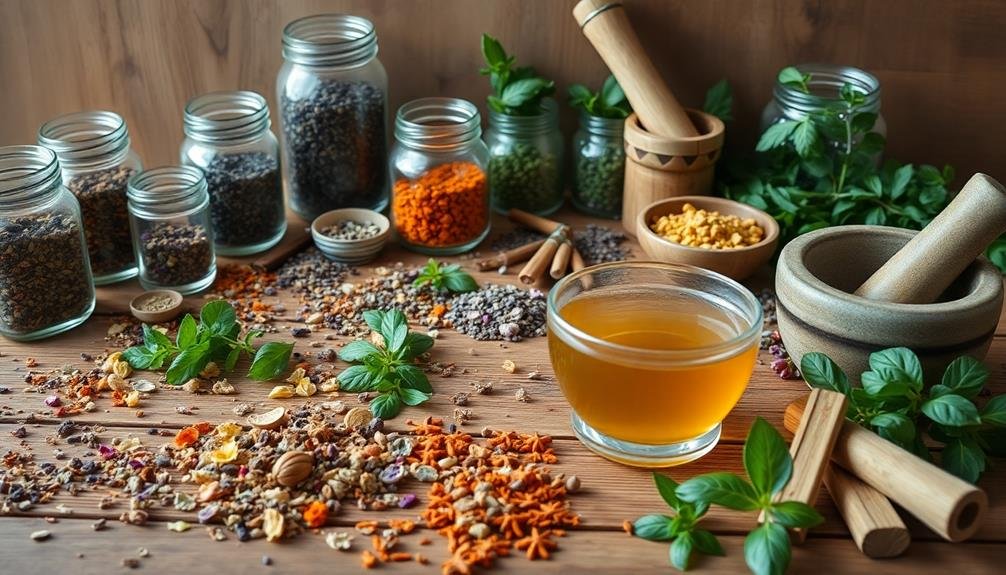
When you're blending herbal teas, exploring different flavor profiles can lead to delightful surprises.
You can adjust the strength and aroma of your blend to match your personal preferences, creating a unique experience with each cup.
Don't hesitate to experiment; your perfect tea is just a few tweaks away!
Flavor Profiles Exploration
Exploring flavor profiles in herbal tea blending opens up a world of creativity and personalization.
You can transform your blends by experimenting with different ingredients and combinations. Here are four key elements to contemplate when crafting your perfect infusion:
- Base Herbs: Start with a solid foundation using herbs like chamomile, peppermint, or rooibos. These will set the tone for your blend.
- Complementary Flavors: Add herbs that enhance your base, such as lavender for a floral note or ginger for a spicy kick. Balance is key, so think about how each flavor interacts.
- Fruit Additions: Dried fruits like apple slices or berries can introduce natural sweetness and acidity, enriching the overall profile.
- Spices and Zests: A pinch of cinnamon or a dash of citrus zest can elevate your blend, adding warmth and brightness that makes a difference.
Adjusting Strength and Aroma
Adjust your herbal tea blends by fine-tuning strength and aroma to match your personal preference. Start by adjusting the steeping time; a longer steep usually intensifies the flavor and aroma, while a shorter one yields a milder cup. Experiment with different durations to discover what you enjoy most.
Next, focus on the ratio of herbs to water. For a more robust infusion, use a higher herb-to-water ratio; for a lighter flavor, decrease the amount of herbs. Keep track of your ratios so you can replicate your favorite blend later.
You can also play with the type of herbs you use. Adding a pinch of peppermint or ginger can brighten the aroma, making your tea more invigorating. Conversely, using chamomile or lavender can create a soothing, calming effect.
Don't forget about the water temperature, either. Some herbs prefer hotter water, while others release their flavors better in cooler temperatures.
Frequently Asked Questions
How Long Should I Steep My Herbal Tea Blend?
You should steep your herbal tea blend for about 5 to 10 minutes, depending on the ingredients. Experiment a bit to find your perfect flavor profile. Don't forget to taste as you go!
Can I Use Dried Herbs Instead of Fresh Ones?
Yes, you can definitely use dried herbs instead of fresh ones. Just remember, dried herbs are more concentrated, so you'll need less. Adjust your measurements to keep your infusion balanced and flavorful. Enjoy experimenting!
What's the Best Temperature for Brewing Herbal Tea?
You'll want to brew herbal tea at temperatures between 200°F to 212°F. This range helps extract the flavors and benefits from the dried herbs effectively, ensuring a rich and aromatic infusion in every cup.
How Do I Know if My Blend Is Balanced?
To know if your blend's balanced, taste it! If one flavor overpowers the others, adjust ratios. You can also experiment with steeping times; sometimes, a slight tweak can create harmony among the ingredients.
Can I Blend Herbs With Other Ingredients Like Fruits or Spices?
Absolutely, you can blend herbs with fruits or spices! Experimenting with different combinations can enhance flavors and create unique infusions. Just remember to balance the ingredients to achieve a harmonious taste you'll love.
In Summary
Incorporating herbal tea blending into your routine opens up a world of flavors and benefits. By understanding the basics and experimenting with essential ingredients, you can create personalized infusions that suit your taste and mood. Don't hesitate to play around with different ratios and seasonal ingredients to find your perfect blend. With the right tools and storage tips, you'll be well on your way to savoring delightful herbal teas that enhance your well-being. Enjoy the journey!

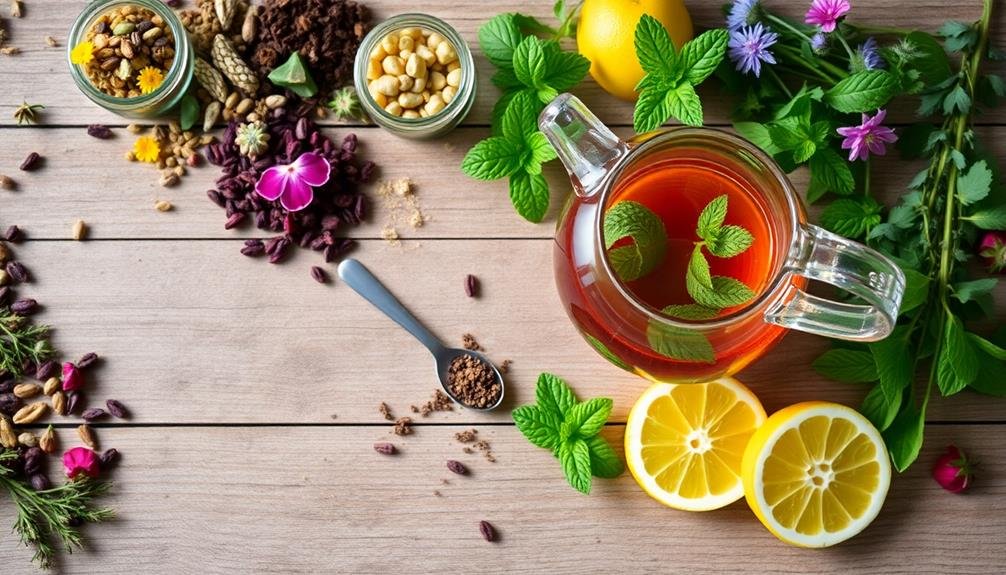
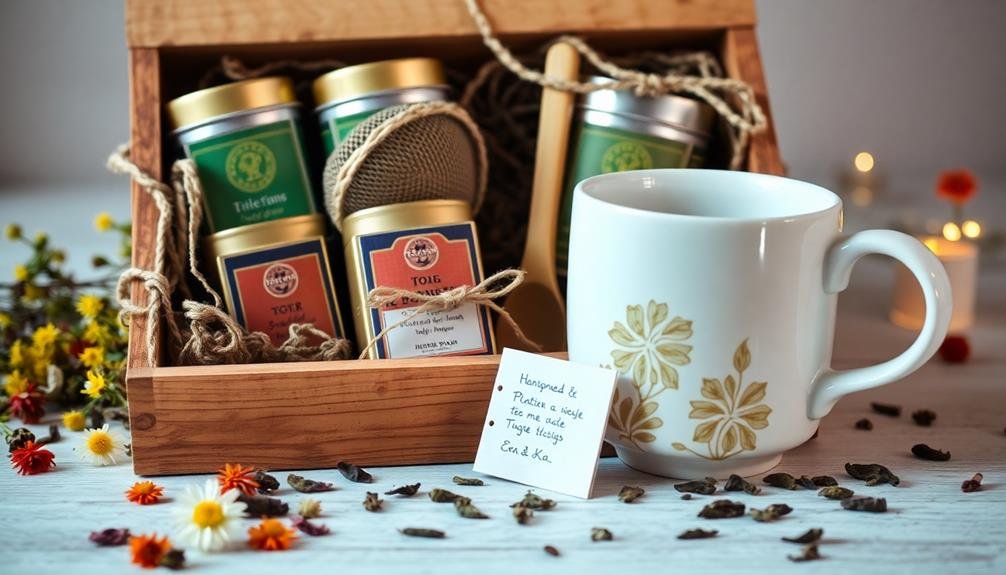
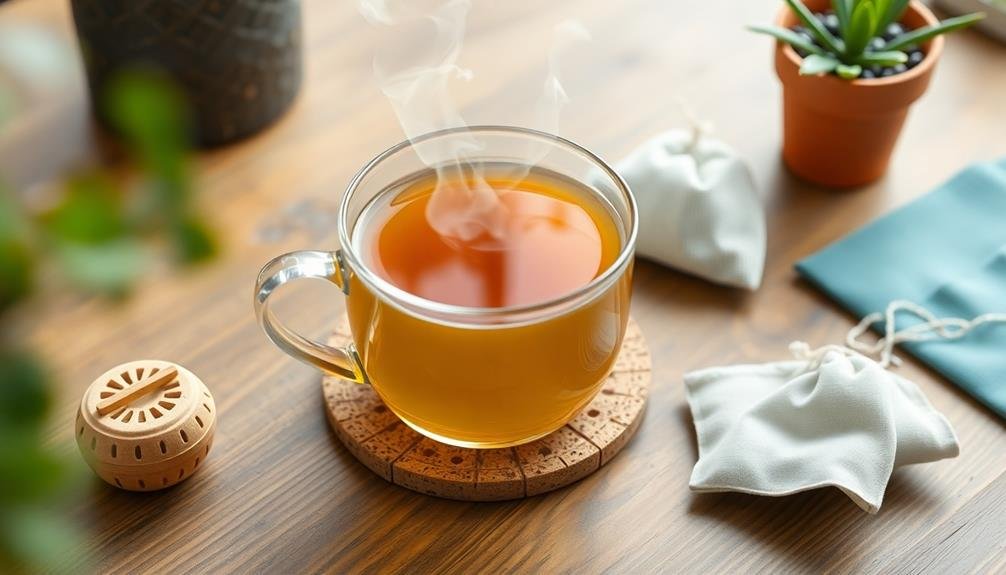
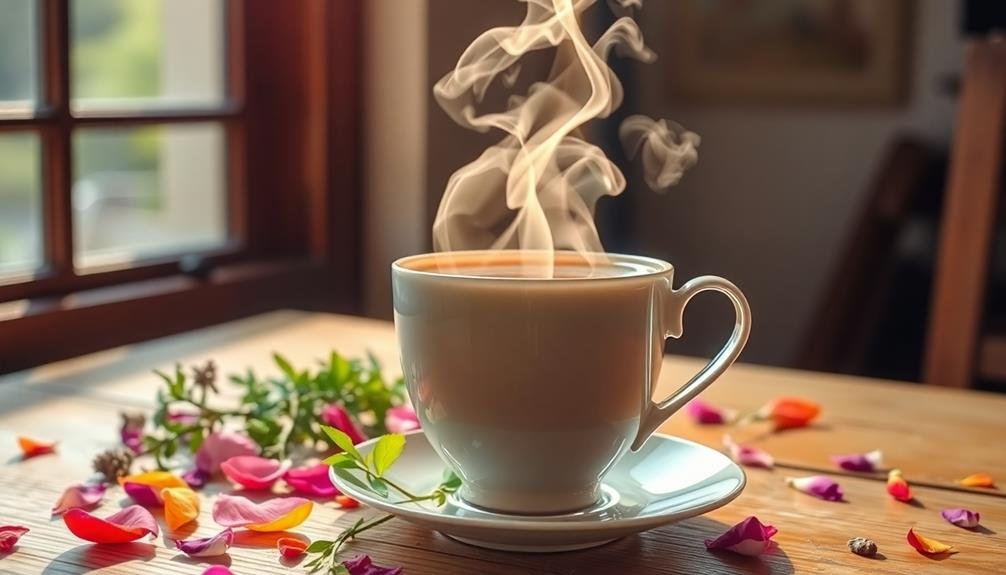
Leave a Reply